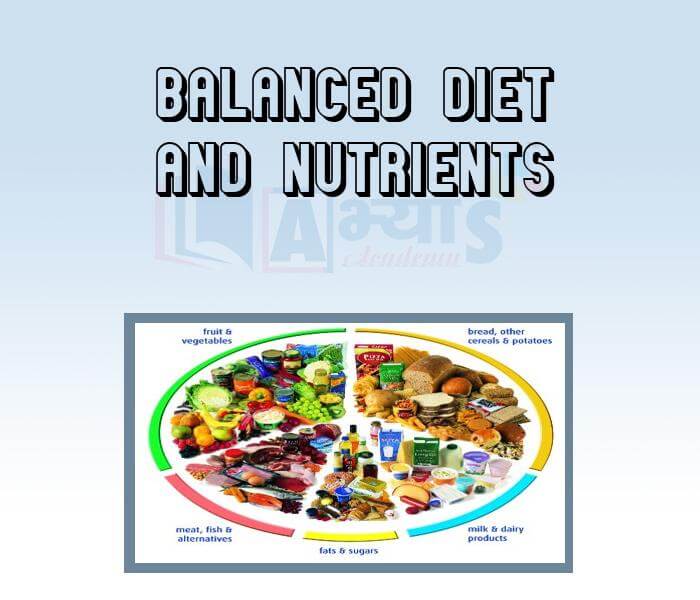Balanced Diet and Nutrients


Balanced Diet and Nutrients
Balanced Diet:
The food we normally eat in a day is our diet. For growth and maintenance of good health, our diet should have all the nutrients that our body needs, in right quantities. Not too much of one and too little of the other. The diet should also contain a good amount of roughage and water. Such a diet is called a balanced diet. Pulses, groundnut, soyabean, sprouted seeds, fermented foods a combination of flour, banana, spinach, sattu, jaggery, available vegetables and other such foods provide many nutrients.
The diet which contains all the essential nutrients in the right proportion is called a balanced diet. The food we eat must have all the nutrients. It should provide the required energy. Deficiency of one or more nutrients in our food for a long time may cause certain diseases or disorders.
Importance of Balanced Diet:
Elements that affect Balanced Diet
1. Age. :- Infants and boys require more nutritious elements than adolescents and adults, mainly because their physical development speed is faster than adolescents and adults.
Meat alone is sufficient to provide all nutrients of the body. | |||
| Right Option : B | |||
| View Explanation | |||
The Amount of food taken by an organism at a time is called diet. | |||
| Right Option : A | |||
| View Explanation | |||
Not eating too much or too little means we are eating in ____________________. | |||
| Right Option : C | |||
| View Explanation | |||
Students / Parents Reviews [10]
Abhyas is a complete education Institute. Here extreme care is taken by teacher with the help of regular exam. Extra classes also conducted by the institute, if the student is weak.

Om Umang
10thI have spent a wonderful time in Abhyas academy. It has made my reasoning more apt, English more stronger and Maths an interesting subject for me. It has given me a habbit of self studying

Yatharthi Sharma
10thIt was good as the experience because as we had come here we had been improved in a such envirnment created here.Extra is taught which is beneficial for future.

Eshan Arora
8thIt was a good experience with Abhyas Academy. I even faced problems in starting but slowly and steadily overcomed. Especially reasoning classes helped me a lot.

Cheshta
10thMy experience was very good with Abhyas academy. I am studying here from 6th class and I am satisfied by its results in my life. I improved a lot here ahead of school syllabus.

Ayan Ghosh
8thAbout Abhyas metholodology the teachers are very nice and hardworking toward students.The Centre Head Mrs Anu Sethi is also a brilliant teacher.Abhyas has taught me how to overcome problems and has always taken my doubts and suppoeted me.

Shreya Shrivastava
8thOne of the best institutes to develope a child interest in studies.Provides SST and English knowledge also unlike other institutes. Teachers are co operative and friendly online tests andPPT develope practical knowledge also.

Aman Kumar Shrivastava
10thIt has a great methodology. Students here can get analysis to their test quickly.We can learn easily through PPTs and the testing methods are good. We know that where we have to practice

Barkha Arora
10thA marvelous experience with Abhyas. I am glad to share that my ward has achieved more than enough at the Ambala ABHYAS centre. Years have passed on and more and more he has gained. May the centre flourish and develop day by day by the grace of God.

Archit Segal
7thAbhyas Methodology is very good. It is based on according to student and each child manages accordingly to its properly. Methodology has improved the abilities of students to shine them in future.
